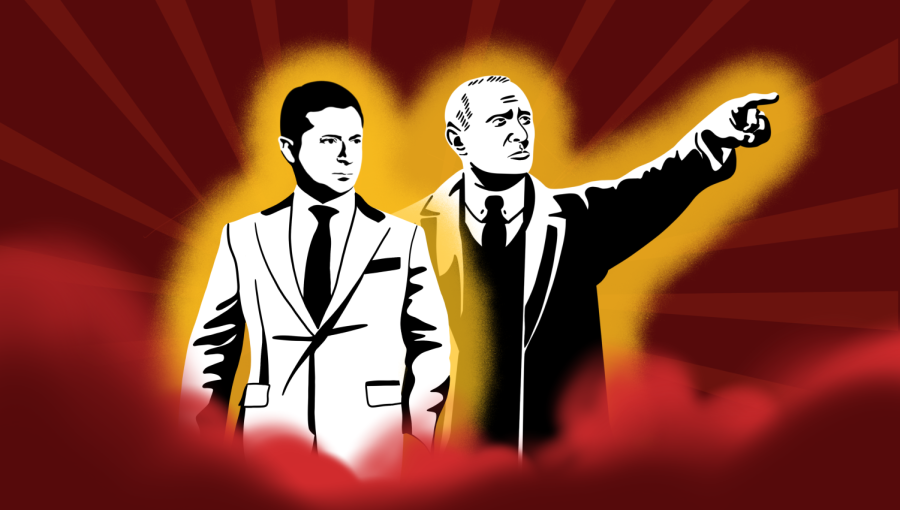What the government doesn’t want you to know
Propaganda spreads a one-sided view of war
Graphic illustration by Chelsea Lee and Anwen Huang
Amid the Russian invasion of Ukraine, there has been heavy propaganda on both sides. Such actions follow historic trends of government wartime propaganda.
April 5, 2022
In a world dominated by mass media, misinformation is inseparable from daily life, hoodwinking audiences into believing everything they see. Especially during war, politicians use propaganda to promote their plans and censor unfavorable opinions. From the Roman Civil Wars in 30 B.C.E. to the recent Russian invasion of Ukraine, propaganda has promoted a one-sided perception of what governments want populations to believe.
“Propaganda is the use of messaging in print, images, motion pictures, audio or any any kind of media to provide a one-sided story for the benefit of a certain point of view,” Foothill College Media Studies faculty member Amy Harrison Shidler said. “It is not balanced, so it does not acknowledge the truths on many sides of the story. Rather, it is a story designed to sway people’s emotions, to move hearts and minds, in sympathy for a particular cause.”
Historically, propaganda has negative connotations associated with promoting or blocking communism. Modern propaganda can be spread through social media, posters, memes and other forms of media, yet subtle propaganda exists in education and news sources. Even advertising can be considered propaganda if it aims to achieve a certain political or economic end.
Currently, propaganda shapes the world’s view on the Russian invasion of Ukraine. In Russia, everything that citizens see and hear about the war is under strict control by the government. To justify its globally condemned invasion, Russia portrays the war as a special military operation to protect Ukrainian civilians from a neo-Nazi government. During a state-televised address on Feb. 24, Russian President Vladimir Putin stated his reasons for launching the operation.
“Russia cannot feel safe, develop and exist with a constant threat emanating from the territory of modern Ukraine,” Putin said.
According to Putin, the bombings are entirely fabricated, and Russian troops are distributing aid to civilians and helping them evacuate to safety. The government claims that Western countries, particularly the U.S., are orchestrating events in Ukraine to overthrow the Ukranian government.
To prevent citizens from discovering the truth, Putin censored the media and cracked down on social media sites. On March 3, he signed a law that would punish anyone spreading information deemed false by authorities. Violators of the law could face up to 15 years in prison. All of the deputies in the State Duma, the lower house of Parliament, voted in support of the law. Many media outlets, such as Echo of Moscow and TV Rain, shut down, and foreign organizations have stopped reporting in Russia. Roskomnadzor, the Russian federal executive agency responsible for managing mass media, also blocked access to the British Broadcasting Corporation’s website and other international news sites. Without any interference, state-run media constantly pushes pro-Kremlin content that reiterates the government’s skewed version of events.
“Especially in the last several years, Russia has managed to channel most of their internet traffic through a couple nodal points so they can sort of bottleneck it, and that allows them to shut things down,” UCLA European History professor Peter Baldwin said. “Western media companies have also shut down their own transmission to Russia. In Russia, many Russians don’t even really know what’s going on.”
While Putin was able to control the press in the country, social media platforms have exploded with opposition to the war. However, after the fake news law was enacted, Roskomnadzor blocked access to Facebook and Twitter in Russia. Instagram’s blockage on March 17 devastated millions, especially influencers and businesses. In addition, the government also weaponized social media by hiring internet trolls, who post anti-Ukrainian content on thousands of different accounts across multiple platforms. Despite the censorship, some Russian citizens have found loopholes by using virtual private networks to mask their locations and access blocked western sites.
In Ukraine, propaganda has largely been on social media and centered around gaining foreign aid, depicting what the invasion is like and contrasting Putin with Ukrainian President Volodymyr Zelensky. Viral videos of Ukrainian soldiers getting married or citizens picking up weapons to defend their families have shown the global audience how the war is playing out in real-time. In addition, pro-Ukrainian posts have flooded VKontakte, a social media platform predominantly used by Russian speakers, to highlight the targeting of civilians within the country. Hashtags associated with the conflict have helped to reach a wide audience within Russia.
“Ukraine is very good at trumpeting how big the losses on the Russian side have been and how small the losses on their side have been, and everybody exaggerates the numbers in their favor,” Baldwin said.
The Ghost of Kyiv, a story about a single pilot who took down multiple Russian jets, has served as a morale booster for Ukrainians. Many claimed that the pilot won six air fights in the skies of Kyiv during the first 30 hours of the invasion. Computer-generated footage of the Ghost of Kyiv winning a dogfight was created using the video game Digital Combat Simulator and uploaded onto the internet, causing the myth to become viral across social media. Whether or not the story is true, the Ghost of Kyiv fostered optimism in the Ukrainian population.
Unlike Putin, Zelensky is actively taking advantage of social media to talk to his citizens as well as the international audience. Zelensky boldly addressed Russians directly in Russian, appealing for peace. In addition, Zelensky takes videos of himself and other cabinet members on the streets of Kyiv leading the defense. These videos helped Ukraine gain international support and have portrayed Zelensky as a global hero.
“Zelensky is an actor,” AP U.S. History teacher Steven Roy said. “He’s on a media blitz, and he is going to be the face of how modern conflicts will look from now on.”
Throughout history, propaganda has remained a wartime staple. In World War II, dictator Adolf Hitler and the National Socialist German People’s party used propaganda to gain power and to convince Germans to reunify and expand territory. The Nazi party used mediums such as entertainment, the radio and educational materials to spread their messages to the German population about their past struggle with foreign enemies. In addition, the Nazi party initiated anti-semitic propaganda campaigns against Jews, portraying them as engaged in a conspiracy to provoke war, which would foreshadow the eventual Holocaust.
“When the Nazi party was first trying to gain power, they wanted to get votes wherever they could get them from: left wing or right wing,” Baldwin said. “They would emphasize different aspects of their ideology depending on what neighborhood they were plastering posters in, and tailor the message depending on who they thought their audience was.”
During the Cold War, the West promoted anti-communist sentiment by running massive propaganda campaigns among citizens and in other countries suspected of joining the pro-communist side. Films and television shows portrayed America as victims of communism and promoted conservative family values.
“There is a product of conformity in the 1950s and 1960s,” Roy said. “In the U.S., ideas are being pushed in education through propaganda videos like ‘How to Spot a Communist’ or even socialization, like ‘How to Go On a Date.’”
Whether it be in art, movies or posters, propaganda continues to shape perspectives of politics and international affairs.
“Anyone can critically analyze a piece of potential propaganda and ask the important questions: ‘Whose point of view is this?’, ‘Who created or paid for this message?’, ‘What is the purpose of this message?’ and ‘How might others perceive this message?’” Shidler said. “When you do that, then you gain some control over the media. It’s always important to think critically and to discuss the ideas presented in the propaganda from multiple perspectives.”




































































